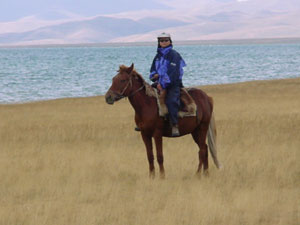![]()
| Kyrgyzstan | Kochkor | 2002.08.31 - 09.02 |
Song-Kul
Song-Kul is a lake at 2900 meters elevation located 100 km west of Kochkor. Devoid of electric power and mobile phone cell sites, Song-Kul is an ideal escape from frenzied life. About one dozen yurts in a 500 sq. km area around the lake charge a fixed fee for B&B accommodation and meals. Some European tourists we met in Bishkek claimed Song-Kul to be their highlight in Kyrgyzstan. We thought otherwise. Other than a walk by the lakeshore and a horse ride through the grassland, there's absolutely nothing else to do. The 100 km lake circumference is flat monotonous grassland. Surrounding mountains are similarly uninteresting. Furthermore, time in the Kyrgyz yurt was more like tourist accommodation than a preferred interactive family experience.
SHEPHERD'S LIFE
The organization Shepherd's Life, founded by a Swiss NGO, places tourists into family homes
and yurts for a published fixed fee. Shepherd's Life coordinators located in cities around
Song-Kul, including Kochkor and Naryn, charge Ks 100 per group to explain the program
and arrange accommodation and transportation. The key advantage to staying at a
Shepherd's Life yurt instead of an independent place is the level of sanitation.
Shepherd's Life member families seem to have been educated not to touch tourist's
food directly after adding dung to the stove. Still, we recommend packing
Ciprofloxacin and Immodium in your emergency kit.
The Shepherd's Life coordinator found another couple for us to split the taxi fare to Song-Kul with. Taxi fare is Ks 900 one-way for the 100 km drive plus Ks 100 per night that the driver waits at Song-Kul. Since it was already early evening, the 4 of us decided to remain in Kochkor for the night and depart to Song-Kul early the next morning. Our wish to stay at a yurt on the north shore of the lake and have vegetarian meals was relayed from the coordinator to the taxi driver to the yurt family. All of our wishes were fulfilled without issue.
Kyrgyz food is good but some dishes are heavy in milk fat. Each morning, the mother used a centrifuge to separate fat from milk milked daily from the family's 60 cows. Whereas we'd prefer to keep the resulting skim milk and dispose the heavy buttery substance, the Kyrgyz people did just the opposite. They dumped the skim milk into the lake and feasted on the glutinous fat. There must be a good reason for this, although we can't imagine what it is. Other than the milk fat, meals consisted of fish, a thick soup with plenty of vegetables, and bread.
The first afternoon, we rode the family's horses. Actually, to say we sat on horses while they walked around is more accurate. During our 1-hour ride (Ks 50 per horse per hour), we saw that the grasslands around Song-Kul are in fact unchanging and monotonous.
We and the other 2 tourists decided that one night in a cold yurt in the middle of uninteresting terrain was enough. That night a steady rain (that leaked in several places into our yurt) turned to snow. By morning, the entire ground was snow covered. Departure looked improbable but we asked the driver to try regardless. It was then that we realized that the driver didn't carry tire chains and that all 4 of his tires were bald. 5 minutes after our attempted departure, we were back at the yurt. The driver and yurt family all seemed to be saying, "See, we told you the taxi wouldn't be able to pass the first snow covered grassy incline." By noon, most of the snow had melted, and we returned to Kochkor.
GETTING TO KOCHKOR
From Bishkek, the best option is to ride a shared taxi from the East Bus Station.
The fare is somewhere between Ks 120~150 per person depending on your negotiation
skills. In a fast car, travel time is 2½ hours.
 |
The taxi arranged by Shepherd's Life in Kochkor took us to a yurt on the north shore of Song-Kul as we had requested. |
 |
We rode horses on our first afternoon at Song-Kul. |
 |
We awoke to an early September 2 snow that accumulated deeper and deeper throughout the morning and hindered our return to Kochkor. |
Copyright © 2000-2002 Wes and Masami Heiser. All rights reserved.